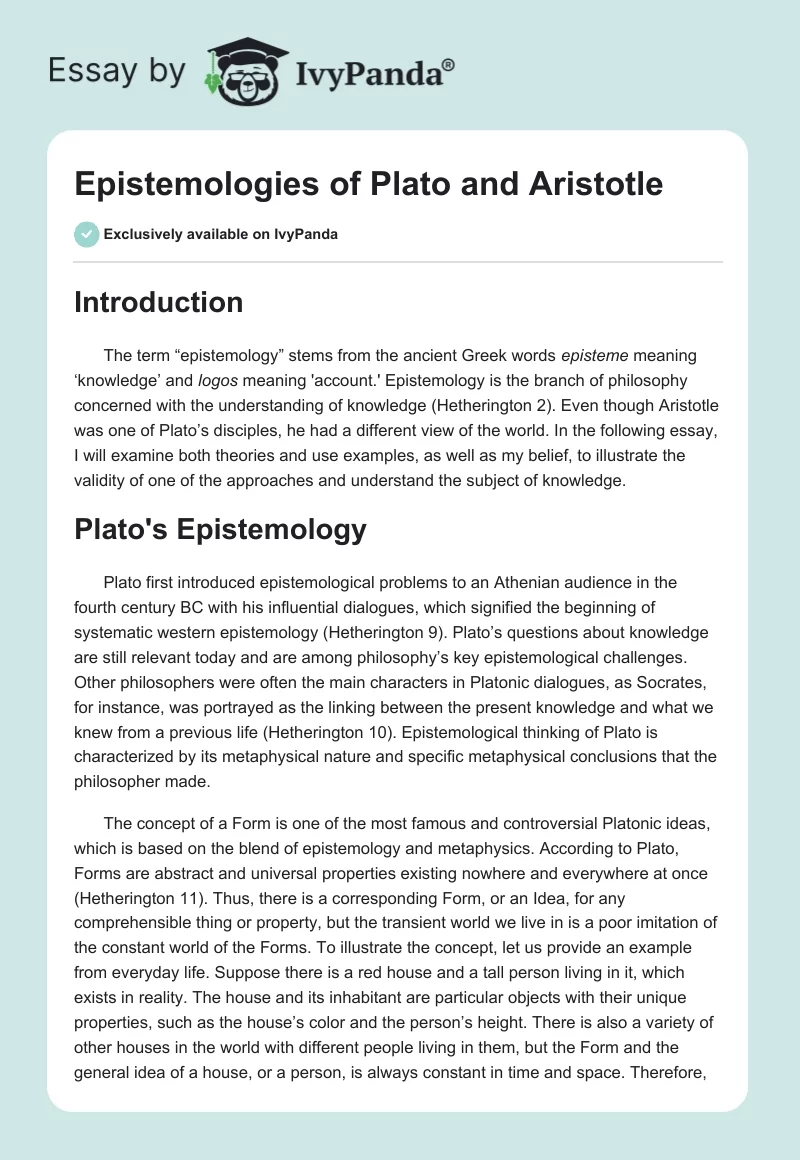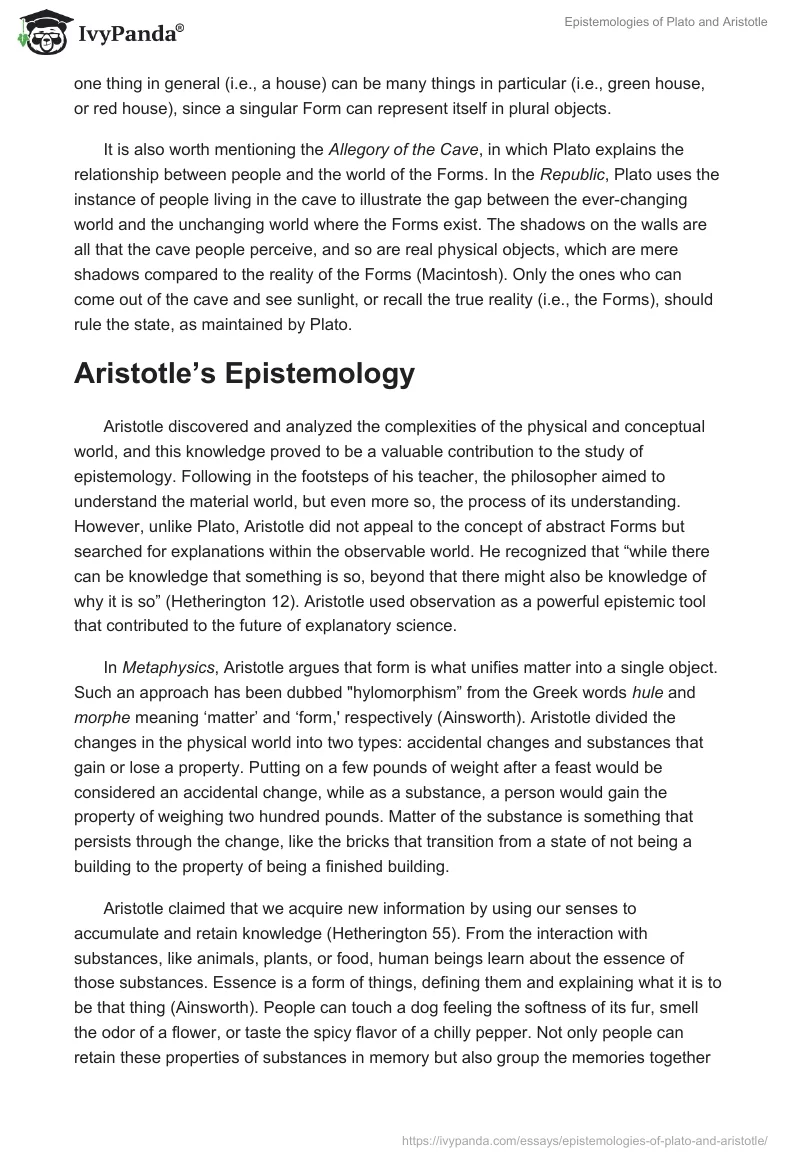Introduction
The term “epistemology” stems from the ancient Greek words episteme meaning ‘knowledge’ and logos meaning ‘account.’ Epistemology is the branch of philosophy concerned with the understanding of knowledge (Hetherington 2). Even though Aristotle was one of Plato’s disciples, he had a different view of the world. In the following essay, I will examine both theories and use examples, as well as my belief, to illustrate the validity of one of the approaches and understand the subject of knowledge.
Plato’s Epistemology
Plato first introduced epistemological problems to an Athenian audience in the fourth century BC with his influential dialogues, which signified the beginning of systematic western epistemology (Hetherington 9). Plato’s questions about knowledge are still relevant today and are among philosophy’s key epistemological challenges. Other philosophers were often the main characters in Platonic dialogues, as Socrates, for instance, was portrayed as the linking between the present knowledge and what we knew from a previous life (Hetherington 10). Epistemological thinking of Plato is characterized by its metaphysical nature and specific metaphysical conclusions that the philosopher made.
The concept of a Form is one of the most famous and controversial Platonic ideas, which is based on the blend of epistemology and metaphysics. According to Plato, Forms are abstract and universal properties existing nowhere and everywhere at once (Hetherington 11). Thus, there is a corresponding Form, or an Idea, for any comprehensible thing or property, but the transient world we live in is a poor imitation of the constant world of the Forms. To illustrate the concept, let us provide an example from everyday life. Suppose there is a red house and a tall person living in it, which exists in reality. The house and its inhabitant are particular objects with their unique properties, such as the house’s color and the person’s height. There is also a variety of other houses in the world with different people living in them, but the Form and the general idea of a house, or a person, is always constant in time and space. Therefore, one thing in general (i.e., a house) can be many things in particular (i.e., green house, or red house), since a singular Form can represent itself in plural objects.
It is also worth mentioning the Allegory of the Cave, in which Plato explains the relationship between people and the world of the Forms. In the Republic, Plato uses the instance of people living in the cave to illustrate the gap between the ever-changing world and the unchanging world where the Forms exist. The shadows on the walls are all that the cave people perceive, and so are real physical objects, which are mere shadows compared to the reality of the Forms (Macintosh). Only the ones who can come out of the cave and see sunlight, or recall the true reality (i.e., the Forms), should rule the state, as maintained by Plato.
Aristotle’s Epistemology
Aristotle discovered and analyzed the complexities of the physical and conceptual world, and this knowledge proved to be a valuable contribution to the study of epistemology. Following in the footsteps of his teacher, the philosopher aimed to understand the material world, but even more so, the process of its understanding. However, unlike Plato, Aristotle did not appeal to the concept of abstract Forms but searched for explanations within the observable world. He recognized that “while there can be knowledge that something is so, beyond that there might also be knowledge of why it is so” (Hetherington 12). Aristotle used observation as a powerful epistemic tool that contributed to the future of explanatory science.
In Metaphysics, Aristotle argues that form is what unifies matter into a single object. Such an approach has been dubbed “hylomorphism” from the Greek words hule and morphe meaning ‘matter’ and ‘form,’ respectively (Ainsworth). Aristotle divided the changes in the physical world into two types: accidental changes and substances that gain or lose a property. Putting on a few pounds of weight after a feast would be considered an accidental change, while as a substance, a person would gain the property of weighing two hundred pounds. Matter of the substance is something that persists through the change, like the bricks that transition from a state of not being a building to the property of being a finished building.
Aristotle claimed that we acquire new information by using our senses to accumulate and retain knowledge (Hetherington 55). From the interaction with substances, like animals, plants, or food, human beings learn about the essence of those substances. Essence is a form of things, defining them and explaining what it is to be that thing (Ainsworth). People can touch a dog feeling the softness of its fur, smell the odor of a flower, or taste the spicy flavor of a chilly pepper. Not only people can retain these properties of substances in memory but also group the memories together to form experience. A statue of a dog may look realistic, but it is not the real animal, as it cannot perform a dog’s characteristic functions (i.e., barking), so the essence of a dog is absent in the statue. Thus, every material substance is a unity of form and its matter.
Contrasting the Theories of Plato and Aristotle
Both Plato and Aristotle were concerned with the understanding of the observable world, however, there are significant differences in approaches. Platonic epistemology is based on the concept of abstract Forms representing themselves in various particular objects, while Aristotle believed in the unity of form and matter in different substances. The knowledge, according to Plato’s Allegory of the Cave, can only be recalled from past life, whereas Aristotle claimed that human beings use sensory abilities to gain information from the world around them.
The Third Man argument was initially started by Socrates, but later appeared in Plato’s Parmenides and received its name in Aristotle’s Metaphysics. Plato based the argument on the principle of “one over many,” which means that each form (i.e., F) has one account that provides an explanation of how the F item is F, so a perfect form of a man has F-ness of any man (Fine 239). Only those who had previous knowledge of the Form of Equality can recognize sensible as equal. Aristotle rejected Plato’s argument because “if the Equality is equal to another Equal, there will be more than one Idea of Equality.” (Gerson 230) Thus, Plato believed that the Forms existed independently, while Aristotle doubted the existence of the Forms.
My belief is that education should be available to everyone, which agrees with the epistemology of Aristotle since he stated that we learn about the world through our sensible interaction with substances. The platonic approach is not applicable to my belief as the philosopher denies the possibility of learning for all but the perfect humans able to recall past knowledge. Therefore, Plato reserved the right to learn to the chosen reincarnated individuals, while Aristotle promoted the idea of universal ability to gain knowledge.
Similar to his teacher Plato, Aristotle had a profound impact on philosophy in general, and epistemology in particular. Aristotle’s approach fits my belief best because, as any substances, people can gain the property of knowledge, and thus, everyone can be educated. Overall, the rational thought of Plato and the scientific method of Aristotle can be applied today for a better understanding of knowledge and phenomena surrounding us every day.
Works Cited
Ainsworth, Thomas. “Form vs. Matter,” The Stanford Encyclopedia of Philosophy, edited by Edward N. Zalta, 2016, Web.
Fine, Gail, editor. The Oxford Handbook of Plato. 2nd ed., Oxford University Press, 2019.
Gerson, Lloyd P. Aristotle and Other Platonists. Cornell University Press, 2017.
Hetherington, Stephen, editor. Epistemology: The Key Thinkers. 2nd ed., Bloomsbury Academic, 2019.
Macintosh, David. “Plato: A Theory of Forms.” Philosophy Now, 2012, Web.


